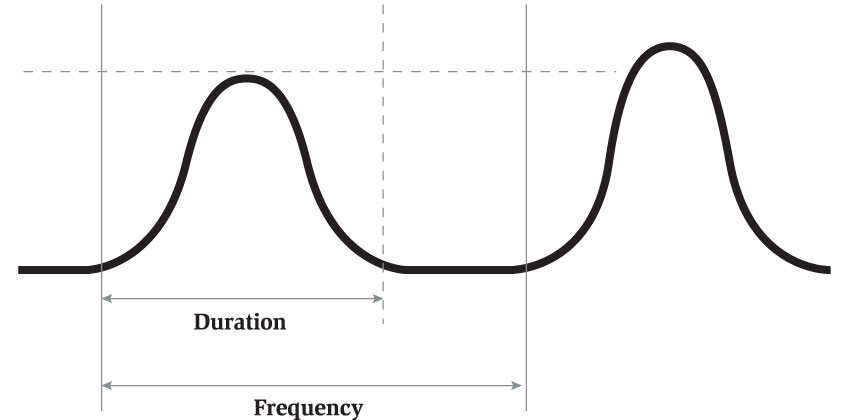Labour & Birth FAQ
How do I know if it is true labour?
What if my membranes (bag of waters) ruptures?
When do I go to my place of birth?
1. How do I time a contraction?
- During labour, contractions build in a wavelike pattern. Each contraction has a buildup, a peak of intensity, and a relaxing phase with a pause of rest before the next contraction begins (see diagram).

- It's helpful to time your contractions to find out if they are regular, and if they are becoming longer and closer together (indicators of the onset of labour).
-
To find out how long your contraction lasts (duration), start timing from the beginning of the contraction to the end of the SAME contraction.
-
To find out how far apart your contractions are (frequency), time from the beginning of one contraction to the beginning of the NEXT contraction.
-
Support persons can time the contractions using a clock, watch or cell phone app and note:
- When each contraction begins and ends
- How long each contraction lasts (duration)
- How far apart the contractions are (frequency)
- How strong the contractions feel
-
It is not necessary to time every contraction in early labour. Start timing your contractions for one hour when they first start to determine a baseline. Wait until there is a noticeable change in the contractions or how you feel, or if your water breaks, then time the contractions again.
2. How do I know if it is true labour?
Pre/Early Labour Signs |
Active Labour Signs |
| Contractions are irregular and do not become stronger | Contractions get longer, stronger, and closer over time |
| Changes in position, rest or emptying your bladder may slow or stop contractions | Changes in position or activity level may not affect the contraction pattern or may increase frequency &/or intensity of contractions |
| No rupture of membranes (bag of waters) | Membranes (bag of waters) rupture |
| No bloody show (vaginal discharge) | Bloody show (vaginal discharge) usually present |
3. What if my membranes (bag of waters) ruptures?
Labour may sometimes start with the rupture of the membrane of the amniotic sac (bag of waters). However, this can occur before or after your contractions start. When it occurs, you might experience a large gush of fluid or a constant trickle of fluid. You should be assessed by a healthcare provider if you think you may be leaking amniotic fluid. If your membranes are ruptured for a prolonged period of time before birth occurs, the risk of infection for you and your baby increases. If your membranes rupture, it is important to note and report the following information to your healthcare provider:
- Colour,
- Odour,
- Amount and
- Time when it happened
Use the acronym C.O.A.T. to help you remember.
- The fluid is normally clear but occasionally may look pink due to bleeding caused by changes in the cervix; this is okay.
- If the fluid is dark or green in colour, go to the hospital right away.
- If there is a large amount of bright‐red bleeding, call 911 for an ambulance to take you to the nearest hospital.
- If you are Group B Streptococcus (GBS) positive, you will also need to go to the hospital right away or call your midwife once your bag of water breaks, so you can receive antibiotics.
4. When do I go to my place of birth?
Every hospital and healthcare provider will have their own recommendations for when to go to the hospital. Your health care provider will provide you with guidelines about when to go to hospital based on your specific situation. Make sure to discuss details of when to contact your midwife if you are having a home birth.
- If you are not sure about what to do, contact your healthcare provider or go into the Obstetrical Triage Unit at the hospital to be assessed.
- Consider using the 5-1-1 rule for when to go to your place of birth if this is your first baby and you are at term (39 or more weeks): “Your contractions are intense enough to require you to focus and breathe rhythmically and are four or five minutes apart, each lasting at least one minute over a period of one hour.”2
Generally, it is recommended that you head to the hospital when:
- You think your water may have broken. It may break in a gush or a small leak, or
- Your contractions have been 5 minutes apart and lasting for 1 minute for 1 full hour and are increasing in intensity (The 5-1-1 rule), or
- Your contractions are regular and 10 minutes apart and the hospital is more than 30 minutes away, or
- If this is not your first baby, your health care provider may suggest that you go to your place of birth as soon as the contractions are 5 minutes apart, or
- At any time when you feel you need help coping with your contractions, or
- If you have any of the pregnancy warning signs

Adapted / Reproduced with permission from Best Start by Health Nexus.
Last modified on: May 17, 2024
References
https://resources.beststart.org/e38e-prenatal-education-program-mainpage/